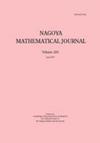求助PDF
{"title":"-zariski曲面奇点对","authors":"CHRISTOPHE EYRAL, MUTSUO OKA","doi":"10.1017/nmj.2023.34","DOIUrl":null,"url":null,"abstract":"Let <jats:inline-formula> <jats:alternatives> <jats:inline-graphic xmlns:xlink=\"http://www.w3.org/1999/xlink\" mime-subtype=\"png\" xlink:href=\"S002776302300034X_inline2.png\" /> <jats:tex-math> $f_0$ </jats:tex-math> </jats:alternatives> </jats:inline-formula> and <jats:inline-formula> <jats:alternatives> <jats:inline-graphic xmlns:xlink=\"http://www.w3.org/1999/xlink\" mime-subtype=\"png\" xlink:href=\"S002776302300034X_inline3.png\" /> <jats:tex-math> $f_1$ </jats:tex-math> </jats:alternatives> </jats:inline-formula> be two homogeneous polynomials of degree <jats:italic>d</jats:italic> in three complex variables <jats:inline-formula> <jats:alternatives> <jats:inline-graphic xmlns:xlink=\"http://www.w3.org/1999/xlink\" mime-subtype=\"png\" xlink:href=\"S002776302300034X_inline4.png\" /> <jats:tex-math> $z_1,z_2,z_3$ </jats:tex-math> </jats:alternatives> </jats:inline-formula>. We show that the Lê–Yomdin surface singularities defined by <jats:inline-formula> <jats:alternatives> <jats:inline-graphic xmlns:xlink=\"http://www.w3.org/1999/xlink\" mime-subtype=\"png\" xlink:href=\"S002776302300034X_inline5.png\" /> <jats:tex-math> $g_0:=f_0+z_i^{d+m}$ </jats:tex-math> </jats:alternatives> </jats:inline-formula> and <jats:inline-formula> <jats:alternatives> <jats:inline-graphic xmlns:xlink=\"http://www.w3.org/1999/xlink\" mime-subtype=\"png\" xlink:href=\"S002776302300034X_inline6.png\" /> <jats:tex-math> $g_1:=f_1+z_i^{d+m}$ </jats:tex-math> </jats:alternatives> </jats:inline-formula> have the same abstract topology, the same monodromy zeta-function, the same <jats:inline-formula> <jats:alternatives> <jats:inline-graphic xmlns:xlink=\"http://www.w3.org/1999/xlink\" mime-subtype=\"png\" xlink:href=\"S002776302300034X_inline7.png\" /> <jats:tex-math> $\\mu ^*$ </jats:tex-math> </jats:alternatives> </jats:inline-formula>-invariant, but lie in distinct path-connected components of the <jats:inline-formula> <jats:alternatives> <jats:inline-graphic xmlns:xlink=\"http://www.w3.org/1999/xlink\" mime-subtype=\"png\" xlink:href=\"S002776302300034X_inline8.png\" /> <jats:tex-math> $\\mu ^*$ </jats:tex-math> </jats:alternatives> </jats:inline-formula>-constant stratum if their projective tangent cones (defined by <jats:inline-formula> <jats:alternatives> <jats:inline-graphic xmlns:xlink=\"http://www.w3.org/1999/xlink\" mime-subtype=\"png\" xlink:href=\"S002776302300034X_inline9.png\" /> <jats:tex-math> $f_0$ </jats:tex-math> </jats:alternatives> </jats:inline-formula> and <jats:inline-formula> <jats:alternatives> <jats:inline-graphic xmlns:xlink=\"http://www.w3.org/1999/xlink\" mime-subtype=\"png\" xlink:href=\"S002776302300034X_inline10.png\" /> <jats:tex-math> $f_1$ </jats:tex-math> </jats:alternatives> </jats:inline-formula>, respectively) make a Zariski pair of curves in <jats:inline-formula> <jats:alternatives> <jats:inline-graphic xmlns:xlink=\"http://www.w3.org/1999/xlink\" mime-subtype=\"png\" xlink:href=\"S002776302300034X_inline11.png\" /> <jats:tex-math> $\\mathbb {P}^2$ </jats:tex-math> </jats:alternatives> </jats:inline-formula>, the singularities of which are Newton non-degenerate. In this case, we say that <jats:inline-formula> <jats:alternatives> <jats:inline-graphic xmlns:xlink=\"http://www.w3.org/1999/xlink\" mime-subtype=\"png\" xlink:href=\"S002776302300034X_inline12.png\" /> <jats:tex-math> $V(g_0):=g_0^{-1}(0)$ </jats:tex-math> </jats:alternatives> </jats:inline-formula> and <jats:inline-formula> <jats:alternatives> <jats:inline-graphic xmlns:xlink=\"http://www.w3.org/1999/xlink\" mime-subtype=\"png\" xlink:href=\"S002776302300034X_inline13.png\" /> <jats:tex-math> $V(g_1):=g_1^{-1}(0)$ </jats:tex-math> </jats:alternatives> </jats:inline-formula> make a <jats:inline-formula> <jats:alternatives> <jats:inline-graphic xmlns:xlink=\"http://www.w3.org/1999/xlink\" mime-subtype=\"png\" xlink:href=\"S002776302300034X_inline14.png\" /> <jats:tex-math> $\\mu ^*$ </jats:tex-math> </jats:alternatives> </jats:inline-formula>-Zariski pair of surface singularities. Being such a pair is a necessary condition for the germs <jats:inline-formula> <jats:alternatives> <jats:inline-graphic xmlns:xlink=\"http://www.w3.org/1999/xlink\" mime-subtype=\"png\" xlink:href=\"S002776302300034X_inline15.png\" /> <jats:tex-math> $V(g_0)$ </jats:tex-math> </jats:alternatives> </jats:inline-formula> and <jats:inline-formula> <jats:alternatives> <jats:inline-graphic xmlns:xlink=\"http://www.w3.org/1999/xlink\" mime-subtype=\"png\" xlink:href=\"S002776302300034X_inline16.png\" /> <jats:tex-math> $V(g_1)$ </jats:tex-math> </jats:alternatives> </jats:inline-formula> to have distinct embedded topologies.","PeriodicalId":49785,"journal":{"name":"Nagoya Mathematical Journal","volume":"359 1","pages":""},"PeriodicalIF":0.8000,"publicationDate":"2023-12-05","publicationTypes":"Journal Article","fieldsOfStudy":null,"isOpenAccess":false,"openAccessPdf":"","citationCount":"0","resultStr":"{\"title\":\"-ZARISKI PAIRS OF SURFACE SINGULARITIES\",\"authors\":\"CHRISTOPHE EYRAL, MUTSUO OKA\",\"doi\":\"10.1017/nmj.2023.34\",\"DOIUrl\":null,\"url\":null,\"abstract\":\"Let <jats:inline-formula> <jats:alternatives> <jats:inline-graphic xmlns:xlink=\\\"http://www.w3.org/1999/xlink\\\" mime-subtype=\\\"png\\\" xlink:href=\\\"S002776302300034X_inline2.png\\\" /> <jats:tex-math> $f_0$ </jats:tex-math> </jats:alternatives> </jats:inline-formula> and <jats:inline-formula> <jats:alternatives> <jats:inline-graphic xmlns:xlink=\\\"http://www.w3.org/1999/xlink\\\" mime-subtype=\\\"png\\\" xlink:href=\\\"S002776302300034X_inline3.png\\\" /> <jats:tex-math> $f_1$ </jats:tex-math> </jats:alternatives> </jats:inline-formula> be two homogeneous polynomials of degree <jats:italic>d</jats:italic> in three complex variables <jats:inline-formula> <jats:alternatives> <jats:inline-graphic xmlns:xlink=\\\"http://www.w3.org/1999/xlink\\\" mime-subtype=\\\"png\\\" xlink:href=\\\"S002776302300034X_inline4.png\\\" /> <jats:tex-math> $z_1,z_2,z_3$ </jats:tex-math> </jats:alternatives> </jats:inline-formula>. We show that the Lê–Yomdin surface singularities defined by <jats:inline-formula> <jats:alternatives> <jats:inline-graphic xmlns:xlink=\\\"http://www.w3.org/1999/xlink\\\" mime-subtype=\\\"png\\\" xlink:href=\\\"S002776302300034X_inline5.png\\\" /> <jats:tex-math> $g_0:=f_0+z_i^{d+m}$ </jats:tex-math> </jats:alternatives> </jats:inline-formula> and <jats:inline-formula> <jats:alternatives> <jats:inline-graphic xmlns:xlink=\\\"http://www.w3.org/1999/xlink\\\" mime-subtype=\\\"png\\\" xlink:href=\\\"S002776302300034X_inline6.png\\\" /> <jats:tex-math> $g_1:=f_1+z_i^{d+m}$ </jats:tex-math> </jats:alternatives> </jats:inline-formula> have the same abstract topology, the same monodromy zeta-function, the same <jats:inline-formula> <jats:alternatives> <jats:inline-graphic xmlns:xlink=\\\"http://www.w3.org/1999/xlink\\\" mime-subtype=\\\"png\\\" xlink:href=\\\"S002776302300034X_inline7.png\\\" /> <jats:tex-math> $\\\\mu ^*$ </jats:tex-math> </jats:alternatives> </jats:inline-formula>-invariant, but lie in distinct path-connected components of the <jats:inline-formula> <jats:alternatives> <jats:inline-graphic xmlns:xlink=\\\"http://www.w3.org/1999/xlink\\\" mime-subtype=\\\"png\\\" xlink:href=\\\"S002776302300034X_inline8.png\\\" /> <jats:tex-math> $\\\\mu ^*$ </jats:tex-math> </jats:alternatives> </jats:inline-formula>-constant stratum if their projective tangent cones (defined by <jats:inline-formula> <jats:alternatives> <jats:inline-graphic xmlns:xlink=\\\"http://www.w3.org/1999/xlink\\\" mime-subtype=\\\"png\\\" xlink:href=\\\"S002776302300034X_inline9.png\\\" /> <jats:tex-math> $f_0$ </jats:tex-math> </jats:alternatives> </jats:inline-formula> and <jats:inline-formula> <jats:alternatives> <jats:inline-graphic xmlns:xlink=\\\"http://www.w3.org/1999/xlink\\\" mime-subtype=\\\"png\\\" xlink:href=\\\"S002776302300034X_inline10.png\\\" /> <jats:tex-math> $f_1$ </jats:tex-math> </jats:alternatives> </jats:inline-formula>, respectively) make a Zariski pair of curves in <jats:inline-formula> <jats:alternatives> <jats:inline-graphic xmlns:xlink=\\\"http://www.w3.org/1999/xlink\\\" mime-subtype=\\\"png\\\" xlink:href=\\\"S002776302300034X_inline11.png\\\" /> <jats:tex-math> $\\\\mathbb {P}^2$ </jats:tex-math> </jats:alternatives> </jats:inline-formula>, the singularities of which are Newton non-degenerate. In this case, we say that <jats:inline-formula> <jats:alternatives> <jats:inline-graphic xmlns:xlink=\\\"http://www.w3.org/1999/xlink\\\" mime-subtype=\\\"png\\\" xlink:href=\\\"S002776302300034X_inline12.png\\\" /> <jats:tex-math> $V(g_0):=g_0^{-1}(0)$ </jats:tex-math> </jats:alternatives> </jats:inline-formula> and <jats:inline-formula> <jats:alternatives> <jats:inline-graphic xmlns:xlink=\\\"http://www.w3.org/1999/xlink\\\" mime-subtype=\\\"png\\\" xlink:href=\\\"S002776302300034X_inline13.png\\\" /> <jats:tex-math> $V(g_1):=g_1^{-1}(0)$ </jats:tex-math> </jats:alternatives> </jats:inline-formula> make a <jats:inline-formula> <jats:alternatives> <jats:inline-graphic xmlns:xlink=\\\"http://www.w3.org/1999/xlink\\\" mime-subtype=\\\"png\\\" xlink:href=\\\"S002776302300034X_inline14.png\\\" /> <jats:tex-math> $\\\\mu ^*$ </jats:tex-math> </jats:alternatives> </jats:inline-formula>-Zariski pair of surface singularities. Being such a pair is a necessary condition for the germs <jats:inline-formula> <jats:alternatives> <jats:inline-graphic xmlns:xlink=\\\"http://www.w3.org/1999/xlink\\\" mime-subtype=\\\"png\\\" xlink:href=\\\"S002776302300034X_inline15.png\\\" /> <jats:tex-math> $V(g_0)$ </jats:tex-math> </jats:alternatives> </jats:inline-formula> and <jats:inline-formula> <jats:alternatives> <jats:inline-graphic xmlns:xlink=\\\"http://www.w3.org/1999/xlink\\\" mime-subtype=\\\"png\\\" xlink:href=\\\"S002776302300034X_inline16.png\\\" /> <jats:tex-math> $V(g_1)$ </jats:tex-math> </jats:alternatives> </jats:inline-formula> to have distinct embedded topologies.\",\"PeriodicalId\":49785,\"journal\":{\"name\":\"Nagoya Mathematical Journal\",\"volume\":\"359 1\",\"pages\":\"\"},\"PeriodicalIF\":0.8000,\"publicationDate\":\"2023-12-05\",\"publicationTypes\":\"Journal Article\",\"fieldsOfStudy\":null,\"isOpenAccess\":false,\"openAccessPdf\":\"\",\"citationCount\":\"0\",\"resultStr\":null,\"platform\":\"Semanticscholar\",\"paperid\":null,\"PeriodicalName\":\"Nagoya Mathematical Journal\",\"FirstCategoryId\":\"100\",\"ListUrlMain\":\"https://doi.org/10.1017/nmj.2023.34\",\"RegionNum\":2,\"RegionCategory\":\"数学\",\"ArticlePicture\":[],\"TitleCN\":null,\"AbstractTextCN\":null,\"PMCID\":null,\"EPubDate\":\"\",\"PubModel\":\"\",\"JCR\":\"Q2\",\"JCRName\":\"MATHEMATICS\",\"Score\":null,\"Total\":0}","platform":"Semanticscholar","paperid":null,"PeriodicalName":"Nagoya Mathematical Journal","FirstCategoryId":"100","ListUrlMain":"https://doi.org/10.1017/nmj.2023.34","RegionNum":2,"RegionCategory":"数学","ArticlePicture":[],"TitleCN":null,"AbstractTextCN":null,"PMCID":null,"EPubDate":"","PubModel":"","JCR":"Q2","JCRName":"MATHEMATICS","Score":null,"Total":0}
引用次数: 0
引用
批量引用
-ZARISKI PAIRS OF SURFACE SINGULARITIES
Let $f_0$ and $f_1$ be two homogeneous polynomials of degree d in three complex variables $z_1,z_2,z_3$ . We show that the Lê–Yomdin surface singularities defined by $g_0:=f_0+z_i^{d+m}$ and $g_1:=f_1+z_i^{d+m}$ have the same abstract topology, the same monodromy zeta-function, the same $\mu ^*$ -invariant, but lie in distinct path-connected components of the $\mu ^*$ -constant stratum if their projective tangent cones (defined by $f_0$ and $f_1$ , respectively) make a Zariski pair of curves in $\mathbb {P}^2$ , the singularities of which are Newton non-degenerate. In this case, we say that $V(g_0):=g_0^{-1}(0)$ and $V(g_1):=g_1^{-1}(0)$ make a $\mu ^*$ -Zariski pair of surface singularities. Being such a pair is a necessary condition for the germs $V(g_0)$ and $V(g_1)$ to have distinct embedded topologies.

 求助内容:
求助内容: 应助结果提醒方式:
应助结果提醒方式:


